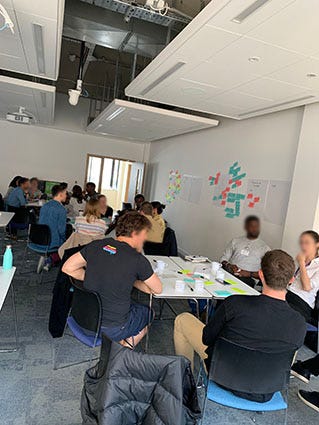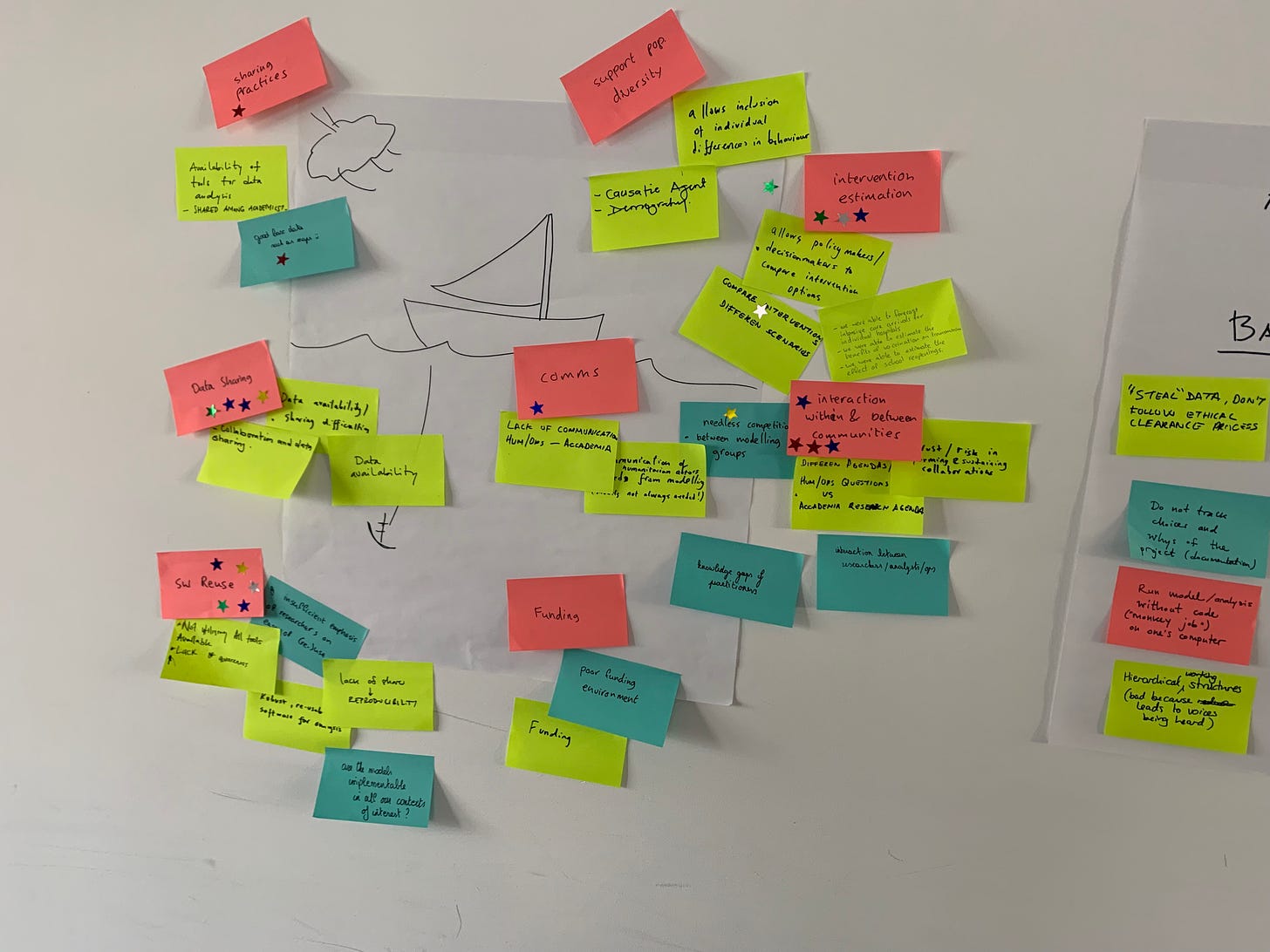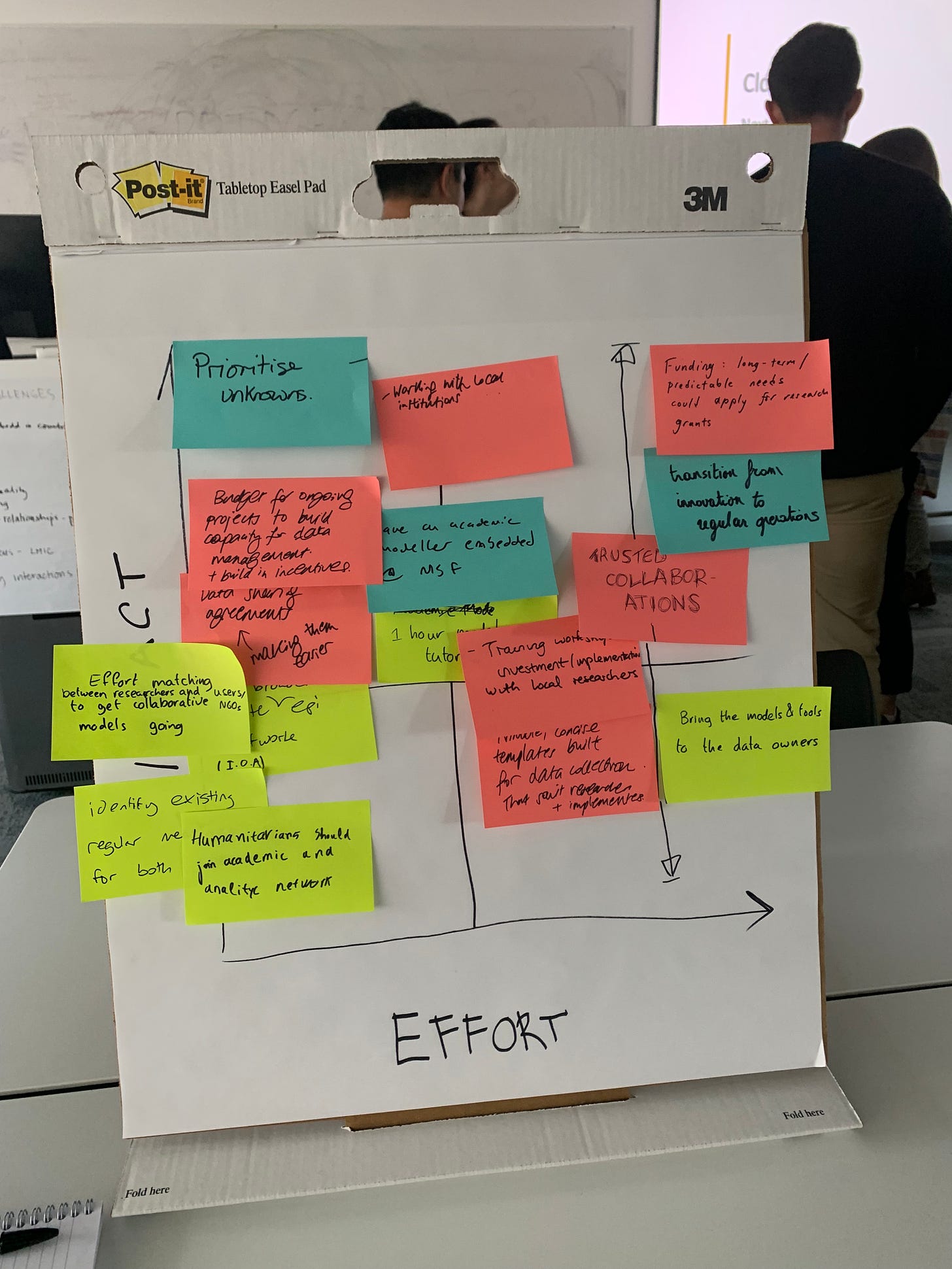Anatomy of a successful workshop
About a week ago I facilitated a lovely, two-hour workshop for a group of people working to improve how computer simulations help fight pandemics and epidemics. The organiser had hit on an important topic: because of rushed uptake of agent-based modelling and other modelling during the pandemic, there was a lack of reflection on the state-of-play and how it could be improved.
The workshop anatomy, which I’ll unpick below, went like this:
icebreaker - floor thermometer
retrospective - what’s been working/not working
break
ideation session - how organisations represented could work together to address identified challenges.
close - impact/effort matrix and round of applause for the work accomplished
The 20 or so participants came from about 7 different large organisations.
Thermometer ice-breaker
Time constraints meant a short ice breaker - the ‘floor thermometer.’ I put up the statement, ‘Computer modelling has reached its full potential for simulating epidemic disease.’ I laid out a line on the floor from ‘totally agree,’ to ‘totally disagree’. We had three types of participants, by expertise, and I had each group take a turn stepping forward onto the line in the place that showed their position of agreement or disagreement with the statement. (more about icebreakers)
This was revealing because two groups chose ‘totally disagree!’ (there was barely space for them all on that end of the thermometer). But one group stood out with a different opinion (they were right in the middle between agree and disagree), which got everyone chatting.
Retrospective
Next, in 3 groups (with a mix of expertise), the participants used the sailboat exercise to conduct a retrospective. They used the sailboat metaphor to identify first what they felt worked (wind in the sails). They responded to the question, ‘what aspects of agent based modelling (or other modelling) helped us move forward in simulating epidemics?’
After several minutes of ‘silent and solo’ writing ideas on sticky notes, the participants posted their notes ‘above the water line’ and discussed the ideas, clustering them into themes. We repeated the process for things that weren’t working (anchors holding us back). (more about ‘silent and solo’ and other key ways of working).
Groups used discussion or dots (stars in this case) to vote and identify their top challenges. (more about ‘dot voting’). We ended this stage with a set of about 6-8 major challenges across the three groups. After reflecting as a whole group, we took a break.
Ideation session
Our next task (in newly mixed groups) was to come up with ideas for how the institutions represented in the room could work together going forward to address the challenges we identified.
For this process I used a counterintuitive exercise. I first asked people to spend a few minutes ‘silent and solo’ coming up with really bad ideas for how to work together. The worst ideas! After people shared their top 1 or 2 worst ideas (and some laughter), they discussed how they could ‘reverse engineer’ some good ideas out of the bad ones.
Close with impact/effort matrix
When we got to the end of the process, each group put forward a couple of their best ideas. Whole group reflection revealed that there were several that were quite easy to do—low hanging fruit—and others more challenging. This was highlighted when the groups concluded by placing the good ideas on an impact/effort matrix.
Now the organiser can carry these ideas forward, and some colleagues were already committing to action.
Reflection, and how this could apply to you
In gathering informal input from the participants, I learned that many of them had never experienced this type of workshop before. It seems presentation-oriented gatherings may be more common in their field. They were amazed at how productive this interactive, cross-organisation workshop was at developing common understanding and motivating future coordination.
This basic workshop ‘anatomy’ (with minor modifications) could work in a lot of other niche ‘ecosystems’ that are emerging or fast changing, where the group wants to assess the state of play and identify how their organisations can work together going forward. Imagine, for example, heat pumps, internet of things (in specific applications), the health aspects of soundscapes, or micro-mobility.
A modification that could work for this type of workshop would be to conduct the retrospective, then brainstorm more specifically on projects that could test ideas for working together on the challenges. These project ideas can even be ‘story boarded’ so everyone gets a sense of what needs to be done, who’d be involved, and what ‘good’ looks like.
Is your area of work also lacking really productive workshops—perhaps relying on short presentations or roundtable discussions? Let me know in the comments.








